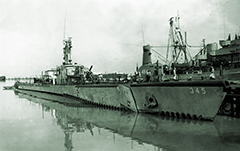USS Cochino Submarine Disaster
USS Cochino (SS-345), a Balao-class submarine, was the only ship of the United States Navy to be named for the cochino, a triggerfish found in the Atlantic. Her keel was laid down by Electric Boat Company of Groton, Connecticut. She was launched on April 20, 1945 sponsored by Mrs. M.E. Serat, and commissioned on August 25, 1945 with Commander W.A. Stevenson in command.
 USS Cochino joined the U.S Atlantic Fleet, cruising East Coast and Caribbean Sea waters from her home port of Key West, Florida. In the late 1940s she received a GUPPY II conversion which streamlined her hull and increased her engine power.
USS Cochino joined the U.S Atlantic Fleet, cruising East Coast and Caribbean Sea waters from her home port of Key West, Florida. In the late 1940s she received a GUPPY II conversion which streamlined her hull and increased her engine power.
On July 18, 1949, Cochino put to sea for a cruise to Britain, and arctic operations. Her group ran through a violent polar gale off Norway, and the joltings received by Cochino played their part on August 25 in causing an electrical fire and battery explosion, followed by the generation of both hydrogen and chlorine gases.
Defying the most unfavorable possible weather conditions, Commander (later Rear Admiral) Rafael Celestino Benítez (1917–1999), commanding officer of Cochino, and his men fought for 14 hours to save the submarine, displaying seamanship and courage. But a second battery explosion on August 26 made "Abandon Ship" the only possible order, and Cochino sank. Tusk's crew rescued all of Cochino's men except for Robert Wellington Philo, a civilian engineer. Six sailors from Tusk were lost during the rescue.
Cochino is one of four United States Navy submarines to be lost since the end of World War II. The others are USS Stickleback, USS Thresher and USS Scorpion. More details
 USS Cochino joined the U.S Atlantic Fleet, cruising East Coast and Caribbean Sea waters from her home port of Key West, Florida. In the late 1940s she received a GUPPY II conversion which streamlined her hull and increased her engine power.
USS Cochino joined the U.S Atlantic Fleet, cruising East Coast and Caribbean Sea waters from her home port of Key West, Florida. In the late 1940s she received a GUPPY II conversion which streamlined her hull and increased her engine power.On July 18, 1949, Cochino put to sea for a cruise to Britain, and arctic operations. Her group ran through a violent polar gale off Norway, and the joltings received by Cochino played their part on August 25 in causing an electrical fire and battery explosion, followed by the generation of both hydrogen and chlorine gases.
Defying the most unfavorable possible weather conditions, Commander (later Rear Admiral) Rafael Celestino Benítez (1917–1999), commanding officer of Cochino, and his men fought for 14 hours to save the submarine, displaying seamanship and courage. But a second battery explosion on August 26 made "Abandon Ship" the only possible order, and Cochino sank. Tusk's crew rescued all of Cochino's men except for Robert Wellington Philo, a civilian engineer. Six sailors from Tusk were lost during the rescue.
Cochino is one of four United States Navy submarines to be lost since the end of World War II. The others are USS Stickleback, USS Thresher and USS Scorpion. More details
